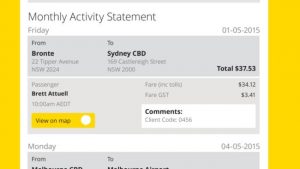GoCatch app goes corporate
Taxi booking app goCatch is setting its sights on snaring corporate clients from traditional networks, with global advisory firm Ernst & Young already on board.
Instead of making regular cab bookings, customers use goCatch’s geolocating app to locate a unoccupied taxi nearby on a map. Participating drivers working with traditional networks also carry the app so they can be geolocated and booked.
The new feature lets employees use the app to charge goCatch rides back to their firm. Companies in turn receive a digitally generated breakdown of staff use and can control staff access.
The service will further cut across the bows of traditional taxi networks who have enjoyed lucrative corporate account arrangements. Last year Uber launched a similar service called “Uber for Business” that is available locally.
GoCatch co-founder and chief executive, Ned Moorfield said 35,000 taxis, more than half the number registered nationally, used the app and the new feature will let a company link multiple staff accounts to one centralised payment account.
“For a staff member that’s set up with access to that account, they’ll see that as a payment option at the end of a trip,” Mr Moorfield said. “You do your normal booking process through goCatch to get yourself a taxi and the end of the trip you’ll see a corporate account as a payment option and the funds for that fare will be charged back to that company’s account.”
GoCatch would send a periodic report to the account holder summarising all staff travel. This could be weekly, fortnightly or monthly and it will be separated out by staff member.

nSample GoCatch monthly report for business
Soon goCatch would limit when staff could charge trips back. “If the company said it wants to allow fares being charged back say, Monday to Friday during regular business hours, it’s the next step for us to add that kind of feature.”
Ernst & Young Australia managing partner, technology, David McGregor, said goCatch’s service offered savings in time, there were no lost receipts and it simplified the accounting process. He said the trial began last month in Sydney.
Mr Moorfield said companies paid the metered fare plus goCatch’s regular 5 per cent payment surcharge nationally. GoCatch also charged drivers a commission of about 5 per cent. “Clearly we’re in this market to provide some much needed competition to networks and to Cabcharge. We think they’ve really fallen behind in their offerings to business users,” he said.
“They (networks) are going to be upset, but that’s the nature of competition and we think we’re delivering a much superior product for business users. In terms of the taxi drivers … they’re still getting the same work they would have got through the network.”
While there was little evidence of networks threatening drivers who used goCatch, there had been isolated incidents in regional areas. “At the regional centres it happens more because they’re one network towns; the networks have very strong market power.”
He said drivers had had enough of the networks “essentially pushing them around”. “Drivers will do what helps them earn more money each shift.”
In another case of industry disruption yesterday, the Australian Competition & Consumer Commission accepted an undertaking from Cabcharge to let competitors process its cards.
An Uber spokeswoman said Uber for Business had seen a massive adoption across the globe. “Since we launched Uber for Business here last year, hundreds of businesses, both small and large, and thousands of employees have made the switch due to the cost savings, the ease of use and the seamless accounting back-end,” he said.